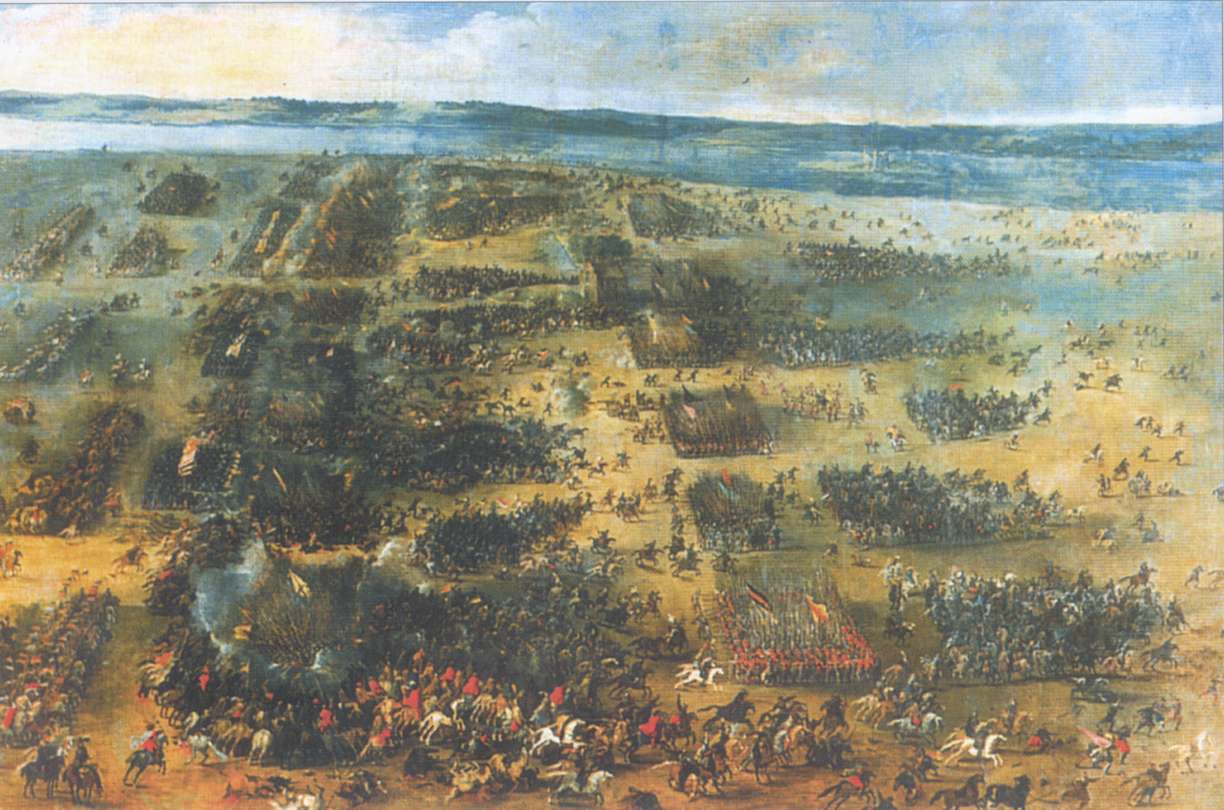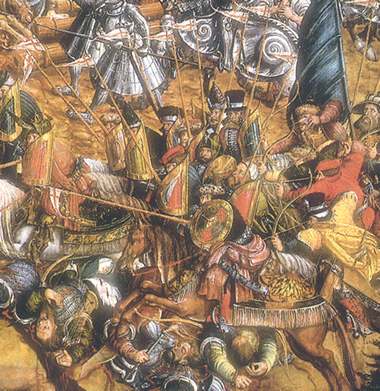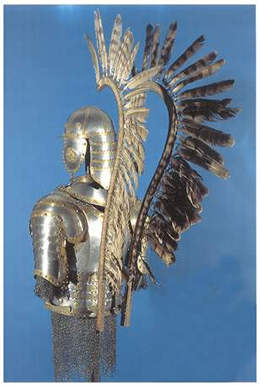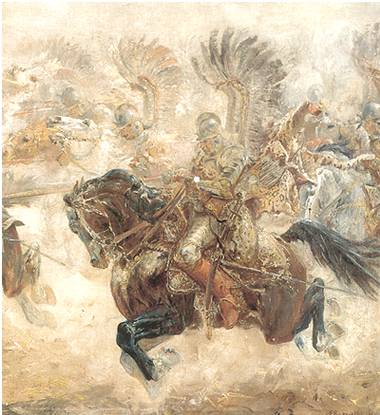

The Swedish king Charles IX laid siege to the city of Riga on September 23, 1605 with an army of 14,000 men. The city controlled the trade routes of the region and was the base of provision for the forces of the Polish commander (Lithuanian hetman) Charles Chodkiewicz. Conquest of this city would mean the gain of a major Baltic harbor and a corresponding reduction of power of the Polish-Lithuanian Commonwealth.

By September 25, 1605 about 3500 men had rallied to Chodkiewicz’s camp, quite a distance from Riga. On the night of September 26, 1605 the army set up camp between Iskiel and Kircholm, having covered 80 kilometers in 36 hours!

The Swedes advanced at night from the evening of the September 26, 1605 with 5000 veteran cavalry, 6000 infantry and 11 artillery guns. Through the early morning mist, the Swedes approached Kircholm. They did not see Polish troops, so Charles IX judged that Chodkiewicz had escaped, frightened by the huge disparity of force. In the meantime the Commonwealth banners were advancing in good order to the north-west from cover to the high ground over Kircholm.
The Swedes stood in four divisions.
In the front, seven battalions of infantry with the artillery batteries. This totaled over 3900 infantry and 11 cannon under Andersen Linderson.
The second division’s six squadrons of cavalry totaled 2200; 1000 under Fredrick Joachim Mansweld and 1200 under Brandt.
The third division, in reserve, consisted of six battalions of infantry and the royal guard, and was led by Prince Lüneburg - 3000 infantry.
The fourth was made up of five troops of Reiter cavalry - 1600 men - who had just arrived under the command of King Charles IX.
The Swedish troops were in an advantageous defensive position at the beginning of battle behind the natural barrier of a stream, and Charles IX was in no hurry to lose his position.
Hetman Chodkiewicz arrayed his army into three divisions.

In the center under command of hetman Vincent Woyna stood 300 hussar troopers (heavy cavalry armed with a long lance, pistols, and sabers), infantry numbering around 1000 men, and 4 to 7 light field artillery pieces. On the right wing of this first division were 700 hussars under Peter Sapieha, and on the left about 900 hussars under Thomas Dabrowa, with some light cavalry.
Duke Frederic Kettler’s 300 Kurlander Reiters (armored cavalry armed with carbines, pistols and swords) - arrived just in time for the start of battle, and formed the second division.
The reserve division consisted of 200 hussars under Captain (Rotmistrz) Theodore Lacki, the light cavalry troops and volunteer nobleman's Panzer Cavalry (mile-armored medium cavalry, armed with short lance, bow, pistols, and sabers).

Hetman Chodkiewicz attempted to provoke the enemy by sending forward numerous skirmishers and bringing up the light artillery. Several hours passed as they probed the strength of the position, but no Swede was lured from the slope. At last Chodkiewicz feigned a retreat.
The Swedish king ordered an attack. Infantry of first Swedish division (3840 men) proceeded uphill toward the infantry in the center. When they approached to close range they were staggered by the heavy fire of the Polish infantry muskets and the cannon. The hetman ordered a counter attack by the 300 hussars under Vincent Woyna.
The hussars picked up great speed down the slope. However, the Swedish footed managed a salvo of musket fire. The Hussars galloped on, not heeding their losses. The Swedish infantry were screened with pike-men, but the hussars pressed home the attack. The sounds of broken lances and pikes intermingled with battle cries, swords crashing, and horses neighing. To assist Woyna’s hussars the Kurlander Reiters were also sent in. Their goal was achieved: the small force overran the 3800 enemy infantry. Remarkably, it was estimated that in this phase of battle, only 13 hussars perished, 17 were wounded, but 150 horses were lost.
The Left Polish wing with the strength of Dabrowa’s 900 hussars reinforced with the light cavalry now fell on the 3 squadrons (1000 men) under Mansfield. The Reiters scattered at the first blow, and fell back in disorder, mixed with the retreating infantry. Polish-Cossacks of the light cavalry moved to pursue from Dabrowa’s regiment, but somehow they turned back in to the right with the hussars and hit the flank and rears of Swedish infantry - combining with the power of Woyna’s hussars and Kettler’ Reiters.
Despite this success, victory was far from certain. On the left Swedish wing most of Brandt’s cavalry started to move in order to turn the flank. In response, Peter Sapieha’s 700 winged Polish hussars and 400 Polish-Cossacks moved from the right wing simultaneously. They broke several companies of the Reiters under Brandt. While the hussars tried to regroup, the Swedish king sends the reserve force of Brandt’s Reiters and his royal guard of 700 men against them. This blow badly deteriorated Peter Sapieha’s position, threatening to cut his force off. Seeing that Charles IX had committed his whole cavalry, Chodkiewicz sent for the 200 hussars under Theodore Lacki, who, swinging far to the right to avoid the ongoing combat, hit the flank of the Swedish cavalry at full tilt.
This final blow determined the result of the battle. The Swedish Reiters begin to flee, exposing the left flank of the infantry, sealing their fate. The duration of the encounter from the first hussar counter attack on the infantry to this point is estimated to be a most a half hour. A vigorous pursuit hounded the Swedes, who tried to rally and defend themselves at several points to save the situation. Around the church of Kircholm Lüneburg’s infantry and some remnants of the Swedish cavalry mounted a defense of the way to Riga under the leadership of King Charles IX. After momentary success, they too were inundated.
The carnage and pursuit continued through the evening…
Chodkiewicz carried the day in a victory that, taking into account the disparity of power and strategic result, was huge. It is estimated that 6000 Swedes died, including Lüneburg and Linderson. King Charles IX was wounded. All the artillery was captured, along with 60 unit banners. Polish losses totaled about 100 killed and a few hundred wounded.



--
http://www.jest.art.pl/kircholm.html







